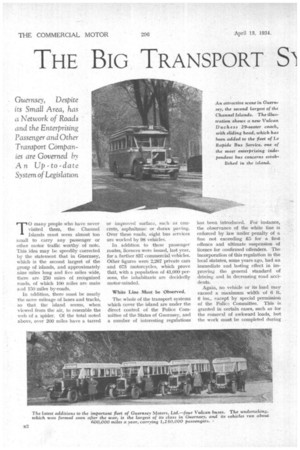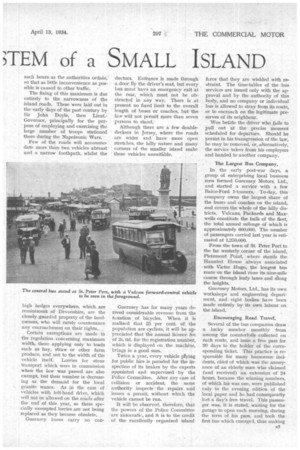THE BIG TRANSPORT S")
Page 42

Page 43

Page 44

If you've noticed an error in this article please click here to report it so we can fix it.
;TEM of a SMALL ISLAND T0 many people who have never visited them, the Channel Islands must seem almost too small to carry any passenger or other motor traffic worthy of note. This idea may be speedily corrected by the statement that in Guernsey, which is the second largest of the group of islands, and approximately nine miles long and five miles wide, there are 250 miles of recognized roads, of which 100 miles are main and 150 miles by-roads.
In addition, there must be nearly the same mileage of lanes and tracks, so that the island seems, when viewed from the air, to resemble the web of a spider. Of the total noted above, over 200 miles have a tarred or improved surface, such as concrete, asphaltmac or durax paving. Over these roads, eight bus services are worked by 98 vehicles.
In addition to these passenger routes, licences were issued, last year, for a further 837 commercial vehicles. Other figures were 2,267 private cars and 673 motorcycles, which prove that, with a population of 41,000 persons, the inhabitants are decidedly motor-minded.
White Line Must be Observed.
The whole of the transport systems which cover the island are under the direct control of the Police Committee of the States of Guernsey, and a number of interesting regulations has been introduced. For instance, the observance of the white line is enforced by law under penalty of a fine not exceeding £5 for a first offence and ultimate suspension of licence for confirmed offenders. The incorporation of this regulation in the local statutes, some years ago, had an immediate and lasting effect in hitpreying the general standard of driving and in decreasing road accidents.
Again, no vehicle or its load may exceed a maximum width of 6 ft. 6 ins., except by special permission of the Police Committee. This is granted in certain cases, such as for the removal of awkward loads, but the work must be completed during such hours as the authorities ordain, so that as little inconvenience as possible is caused to other traffic.
The fixing of this maximum is due entirely to the narrowness of the island roads. These were laid out in the early days of the past century by Sir John Doyle, then Lieut.Governor, principally for the purpose of employing and exercising the large number of troops stationed there during the Napoleonic Wars.
Few of the roads will accommodate more than two vehicles abreast and a narrow foothpath, whilst the high hedges everywhere, which are reminiscent of Devonshire, are the closely guarded property of the landowners, who will rarely countenance any encroachment on their rights.
Certain exemptions are made in the regulation concerning, maximum width, these applying only to loads such as hay, straw or other farm produce, and net to the width of tile vehicle itself. Lorries for stone transport which were in commission when the law was 'passed are also exempt, but their number is decreasing as the demand for the local granite wanes. As in the case of vehicles with left-hand drive, which will not be allowed on the roads after the end of this year, so these specially exempted lorries are not being replaced as they become obsolete.
Guernsey buses carry no con
ductors. Entrance is made through a door 13y the driver's seat, but every bus must have an emergency exit at the rear, .which must not be obstructed in any way. There is at present no fixed limit to the overall length of buses or coaches, but the law will not permit more than seven persons to stand.
Although there are a few doubledeckers in Jersey, where the roads are wider and have more open stretches, the hilly nature and many corners of the smaller island make these vehicles unsuitable.
Guernsey has for many years derived considerable revenue from the taxation of bicycles. When it is realized that 25 per cent, of the population are cyclists, it will be appreciated that the annual licence fee of 2s. 6d. for the registration number, which is displayed on the machine, brings in a good sum.
Twice a year, every vehicle plying for public hire is paraded for the inspection of its brakes by the experts appointed ad supervised by the Police Committee. After any case of collision or accident, the same authority inspects the repairs and 'issues a permit, without which the vehicle cannot be run.
It will be observed, therefore, that the powers of the Police Committee are autocratic, and it is to the credit of the excellently organized island force that they are wielded with restraint. The time-tables of the bus services are issued only with the approval and by the authority of this body, and no company or individual bus is allowed to stray from its route, or to encroach on the legitimate preserves of its neighbour.
Woe betide the driver who fails to pull out at the precise moment scheduled for departure. Should he persist in his transgression of the law, he may be removed, or, alternatively, the service taken from his employers and handed to another company.
The Largest Bus Company,
In the early post-war days, a group of enterprising local business men formed Guernsey Motors, Ltd., and started a service with a few Baico-Ford 1-tonners. To-day, this company owns the largest share of the buses and coaches on the island, and covers the whole of the hilly districts. Vulcans, Packards and Maxwells constitute the bulk of the fleet, the total annual mileage of which is approximately 600,000. The number of passengers carried last year is estimated at 1,250,000.
Frcma the town of St. Peter Port to the far westerly corner of the island, Pleinmont Point, where stands the Haunted House always associated with Victor Hugo, the longest bus route on the island runs its nine-mile course through leafy lanes and along the heights.
Guernsey Motors, Ltd., has its own workshops and engineering department, and eight bodies have been made entirely by its own labour on the island.
Encouraging Road Travel. Several of the bus companies draw a lucky number monthly from among the counterfoils collected on each route, and issue a free pass for 30 days to the holder of the corresponding ticket. This practice is responsible for many humorous incidents, chief of which was the annoyance of an elderly man who claimed (and received) an extension of 24 hours, because the winning numbers, of which his was one, were published only in the evening edition of the local paper and he had consequently lost a day's free travel. This passenger was, it is stated, waiting for the garage to open each morning, during the term of his pass, and took the first bus which emerged, thus making 53 sure of the utmost value from his concession.
There are no trains on the island, but the Guernsey Railway Co. controls the -tramways, as well as a large fleet of buses. The trams are shortly to be abolished in favour of the more mobile form of transport. The remaining bus services are in the hands of private individuals, and, although direct competition is eliminated by the system of police control, this has not robbed the proprietors of a commendable pride in their rolling stock.
One of the most progressive of the private concerns is La Rapide Service, owned by Mr. E. Stead, which covers the centre of the island from east coast to west. Three DodgeGraham 21-seater open vehicles have carried a total of 180,000 passengers per annum, with an average mileage of 30,000-50,000 a year per vehicle. This season, a new Vulcan 29-seater saloon coach with a Strachans body is being added to this fleet. It is upholstered in red leather and has a sliding roof.
The north end of the island is low lying and flat, and, consequently, fares on the coaches serving this district are lower than where steep hills are constantly being encountered. A. reasonable average taken over the whole island is, however, Id. per mile. That such a small area should be so well favoured with passengertransport facilities reflects credit on the travel-mindedness of the public, which alone makes these services remunerative. An instance of the harmony which prevails amongst the various coach proprietors themselves was seen last summer, when the three companies mentioned above united under one management for the purpose of conducting a series of moonlight drives and treasure hunts, which were well patronized.
For the illustrations accompanying this article we are indebted to the Guernsey Evening Press, Mr. Nor man Grut and Mr. A. J. Keates.


























































































